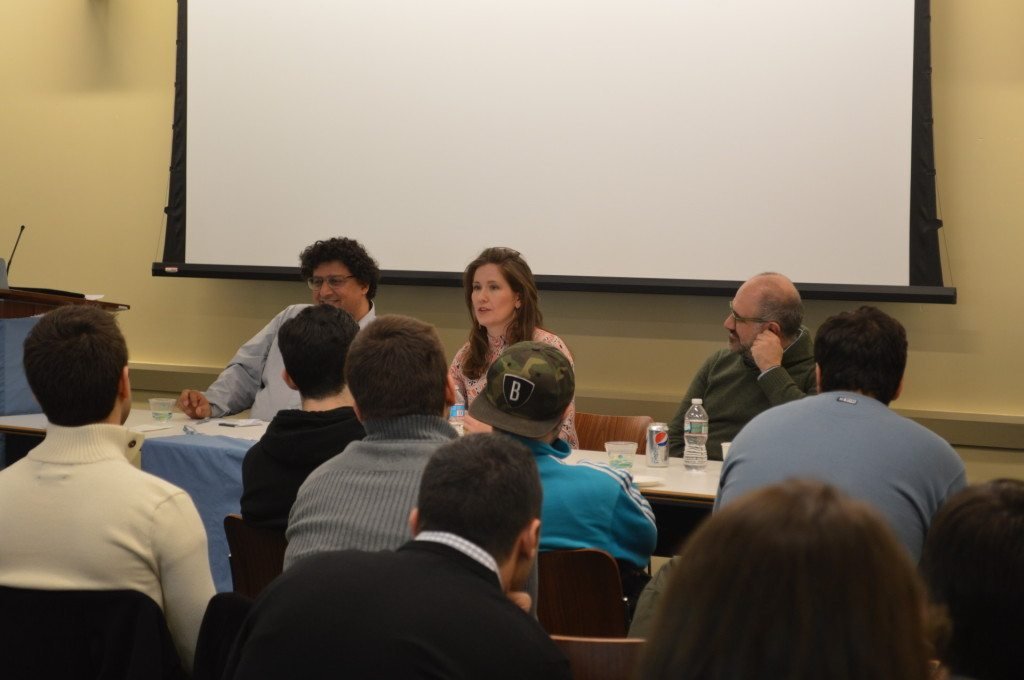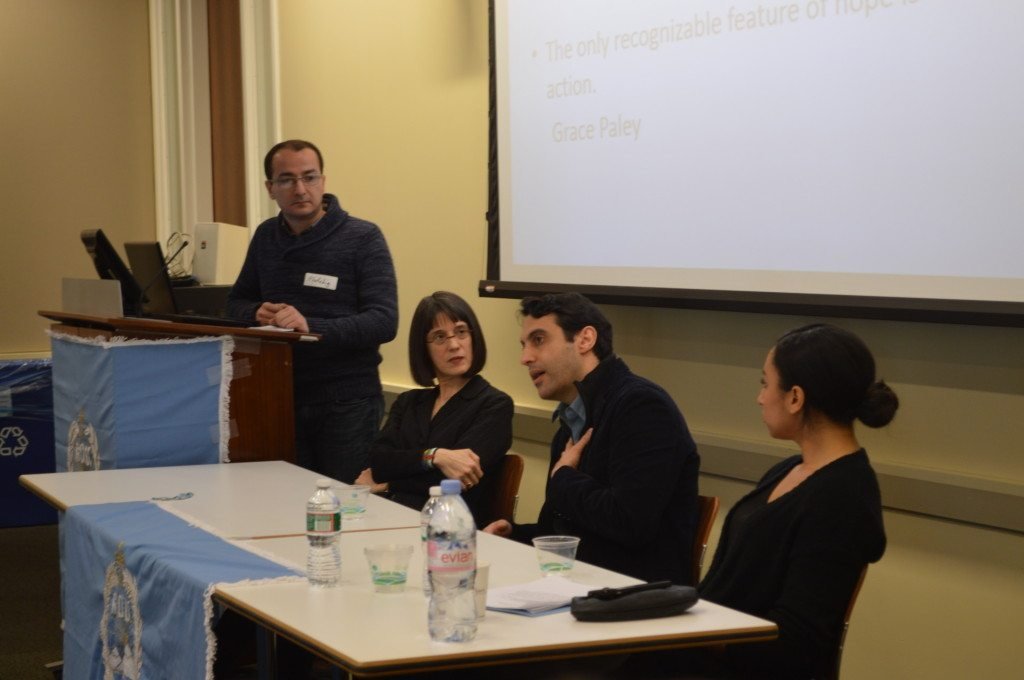Special for the Armenian Weekly
The Armenian Relief Society’s (ARS) 2014 Youth Connect Program at New York University took place in front of a packed room on Sat., March 1. Divided into a morning and afternoon panel, with a keynote speaker in between, the program drew roughly 60 college students of Armenian descent, some traveling from as far as Michigan to attend.

After an introduction from Silva Bedian of the ARS Eastern USA Board, the program was handed over to its director, Khatchig Mouradian, editor of the Armenian Weekly.
The morning panel was comprised of Talin Avakian, Raffi Khatchadourian, and Nancy Kricorian. Avakian, the first presenter, is a young filmmaker in the Boston area and a recent graduate of MassArt, who currently works as a videographer and editor at an ad agency. She screened an excerpt from her short film, “Demi Pointe,” which won the 2013 Boston International Film Festival’s “Indie Soul Best Picture Award.”
Following the screening, Avakian’s presentation centered on her experience growing up multiracial. She acknowledged the complications of growing up with a complex Armenian, African-American, and Native-American identity, but described it as “a great blessing.” She has maintained her ties to all three communities throughout her life, stating, “It’s no coincidence that I was born into three groups of oppressed people.” All aspects of her heritage influence her art, and her goal is to help all three groups through her passion for art and storytelling. Avakian’s stories focus particularly on themes of adolescence and youth psychology, and “Demi Pointe” is filmed from the point of view of a young girl. She explained how the “honest, vulnerable, curious” outlook of children informs their sense of reality and provides storylines and perspectives otherwise inaccessible to adults; her work aims to reconnect people with this side of themselves.

Raffi Khatchadourian, a journalist at The New Yorker, also began his career fascinated by art. A native of New York, he received a Watson Fellowship to study manuscript painting in Armenia as part of his art studies. Along the way, his interest in journalism grew, and he started at the New Yorker as a fact checker 10 years ago. In 2007, he published his first article, a profile of Adam Gadahn, an American who joined al Qaeda. The piece was later nominated for a National Magazine Award in profile writing. “Journalism is ultimately about dealing with unanswered questions,” Khatchadourian explained, and this has led him on many quests for answers, including living with WikiLeaks founder Julian Assange for two weeks in Iceland.
Journalism, Khatchadourian said, requires commitment, dedication, and a strong sense of right and wrong, as well as the confidence to challenge and test one’s convictions. While journalism suffers today from financial constraints and uncertainties about what form its future may take, Khatchadourian notes that it remains meritocratic, and offers many opportunities in its new forms.
The final presenter in the morning panel was novelist Nancy Kricorian, author of Zabelle, Dreams of Bread and Fire, and All the Light There Was. Having grown up in Watertown, Mass., as the granddaughter of a survivor of the Armenian Genocide, Kricorian’s works focus on a central question: How do people maintain their humanity in brutal conflicts? A life-long activist (ever since she joined an anti-vivisection society in the third grade) she has dedicated much of her time to peace activism with CODEPINK Women for Peace, and has also campaigned vigorously against Israel’s violations of international law. Most of the boycotts Kricorian has orchestrated have focused on Israeli companies such as SodaStream and Ahava, which source and produce their goods on occupied Palestinian territory. One of her recent campaigns focused on Scarlett Johansson’s choice to sever her ties with international charity Oxfam in order to remain a brand ambassador for SodaStream, whose factories are located in settlements that are considered in violation of international law. Kricorian’s work with such controversial issues sometimes has had unexpected results, such as when she briefly ended up on a Maryland list of “known terrorists” by mistake, through a misguided and discontinued intelligence-gathering program that was found to have been infiltrating peaceful organizations and arbitrarily designating their members as terrorists.

After the morning panel, Mouradian delivered a keynote presentation about Islamized Armenians. A demographic whose existence has long been unacknowledged, Islamized Armenians were usually women and children who were forcibly converted to Islam when they were taken into Turkish, Kurdish, and Bedouin families during the Armenian Genocide. Forced to abandon their culture, language, and religion, many kept their Armenian identities a secret for decades, even generations, but this is beginning to change, especially in the wake of high-profile cases such as that of Sabiha Gokcen. The adopted daughter of Mustafa Kemal Ataturk, Gokcen was an orphan of the Armenian Genocide. Long revered as Turkey’s first female fighter pilot, Hrant Dink’s 2004 article in the newspaper Agos publicized her Armenian heritage and caused massive uproar in Turkish society. In the wake of Dink’s assassination, many people, including his attorney, Fethiye Cetin, began to examine their family histories and discovered that members of their own families had been “hidden Armenians.”
“Our understanding of ‘survivor’ is limited to our own grandparents,” said Mouradian, “[but] the only difference in [Islamized Armenians’] case is just chance.” Many of these Islamized Armenians were told that no other Armenians had survived the genocide in an effort to cement their isolation. Many live today in the very same villages in which their entire communities were massacred.”
The afternoon panel consisted of Alex Sardar, Kristi Rendahl, and Antranig Kasbarian. Sardar, the vice president of programs at Counterpart International, spoke first, focusing on his experiences living in Armenia for more than a decade and working on issues of citizen engagement. In Armenia, he said, “We don’t know who should be doing what, or how…we lack institutions.” The country’s lack of any collective or institutional memory of self-governance has made the establishment of such institutions very challenging. The government is personality driven, and leaders stay in power by convincing constituents that only they can protect them—what Sardar terms the “under siege mentality,” that allows leaders to create a sense of legitimacy through crisis. Compounding the problem is an impotent media sector and a disengaged citizenry that does not feel secure in their own nation. At the same time, he said, Armenia faces the “most dangerous” kind of emigration: the emerging middle class leaving the country in droves for a more secure future elsewhere.
The second afternoon panelist was Kristi Rendahl, an expert in the non-profit sector who worked in Armenia from 1997-2002. She currently works with the Center for Victims of Torture as an organizational development advisor, and is a monthly columnist for the Armenian Weekly. Rendahl, who was raised on a farm in North Dakota, originally visited Armenia with the Peace Corps, but stayed on for several years and founded the Armenian chapter of Habitat for Humanity. One of the biggest challenges facing Armenian society, according to Rendahl, is the lack of a functioning civil society. The very concept of non-profit work, she explained, is foreign to many Armenians. The Soviet legacy of mandatory volunteerism has clouded many Armenians’ understanding of what voluntary engagement looks like, and has diminished their sense of ownership of their communities and depleted social capital. Rendahl also cautions against bringing American assumptions to work in Armenia; one has to be ready to view issues through a new lens, and to know when to speak and when to listen. And ultimately, she advises, one must be accepting of incremental change.

The final presenter of the program was Antranig Kasbarian, the executive director of the Tufenkian Foundation, whose work focuses on issues of social and economic development in Armenia and Nagorno-Karabagh. A former editor of the Armenian Weekly, Kasbarian also serves on the Central Committee of the ARF Eastern USA. Growing up in what he termed the “bubble” of the diaspora, involvement in Armenian affairs was divided into three spheres: cultural preservation, genocide recognition, and the push for an independent Armenia. Now that an independent Armenia does exist, a whole new set of challenges has presented itself, but these challenges have also vastly broadened the ways in which one can become involved with the country, and its culture and society. The important part, he stressed, is finding meaningful and sustainable forms of engagement.
This engagement forces many in the diaspora to shed the misconceptions they grew up with, such as the ideal of the “perfect Armenians,” or the myth of eventual total repatriation. What is important today, he said, is to progress beyond the Soviet-era expectation of top-down change, to grassroots movements that begin with citizens. This, he noted, is already beginning to emerge. One of its accompanying challenges is to learn how to resist co-opted nationalism, the leadership’s favorite stick with which to beat dissenting elements in Armenian society. Activists, Kasbarian advised, must trump the nationalist credentials of their fasco-nationalist detractors. One is no less Armenian for advocating for change, engagement, accountability, or human rights.
The student audience had a chance to interact with the panelists in the discussion sessions that followed the presentations and during the breaks. After the day’s closing remarks, the students and organizers attended dinner together for further discussion.


Be the first to comment